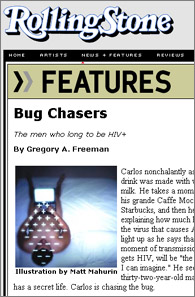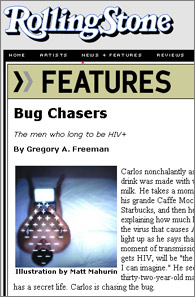AIDS activists and the gay community have focused their attention on an article in the Rolling Stone magazine that 25 percent of newly HIV-positive gay men had actively sought out the virus for erotic kicks or because they see becoming HIV-positive as inevitable and would rather take control of the situation by infecting themselves.

The article claims Dr Bob Cabaj, director of behavioural health services for San Francisco Health Department, gave article author Gregory Freeman the one-in-four estimate, that at "least 25 percent of all newly infected gay men" got that way either by deliberately seeking out HIV-positive partners or "actively seeking HIV" infection.
Cabaj has sent a letter to the magazine denying that he'd ever giving such a figure. He further claims he told the fact checker at Rolling Stone the quote was inaccurate and that it should be pulled. He, however, didn't say in his letter that the problem doesn't exist.
In fact, in asking Rolling Stone to run a clarification, he says he told the magazine only that a "certain percentage" of the new HIV infections might be deliberate. And that the number was "probably more than people wanted to think."
While Freeman flatly dismissed so high a figure, he asserts that the prevalence of "bug chasing" is real and accounts for a higher percentage of HIV infection than health officials or community activists want to admit.
Like most health officials in the US, he says the absence of hard data makes any estimate into the phenomenon completely speculative.
"We have no data to show how many people are participating in this phenomenon," said Jessica Frikey of the Centers for Disease Control and Prevention's National Center for HIV, STD and TB Prevention. "No studies have been done to see how many 'bug chasers' there are."

Dr Marshall Forstein of the Boston-based Fenway Community Health system, told the Washington Times he was credited with acknowledging that "bug chasing" exists and that "bug chasers" are seen regularly in his health system.
"That is entirely a fabrication," Dr Forstein protested. "I have seen two such cases in the last three years, and I can count on one hand how many patients like that I've seen in the last 21 years. I said this was a small phenomenon, that it's a real and significant phenomenon for a specific group of men.
"The real phenomenon in the gay community," Dr Forstein continued, "is that many gay men do not take safe sex seriously. That's a real problem."
The magazine's managing editor, Ed Needham, told Newsweek he stood by the author and the article's fact checker saying, "I have 100 percent confidence in the fact checker� and I have total confidence in the story."
The San Francisco-based Stop AIDS Project also condemned the Rolling Stone story as inaccurate. "We know this is a relatively uncommon behaviour," said project spokeswoman Shana Krochmal. "The numbers in the story are inaccurate."
The debate over the prevalence of this bug chasing subculture is unlikely to fade anytime soon. Next month, a new film called The Gift, which explores the subculture through the eyes of a 21-year-old "bug chaser" in San Francisco, will be shown at the prestigious Berlin International Film Festival.











 Printable Version
Printable Version










Reader's Comments
Be the first to leave a comment on this page!
Please log in to use this feature.